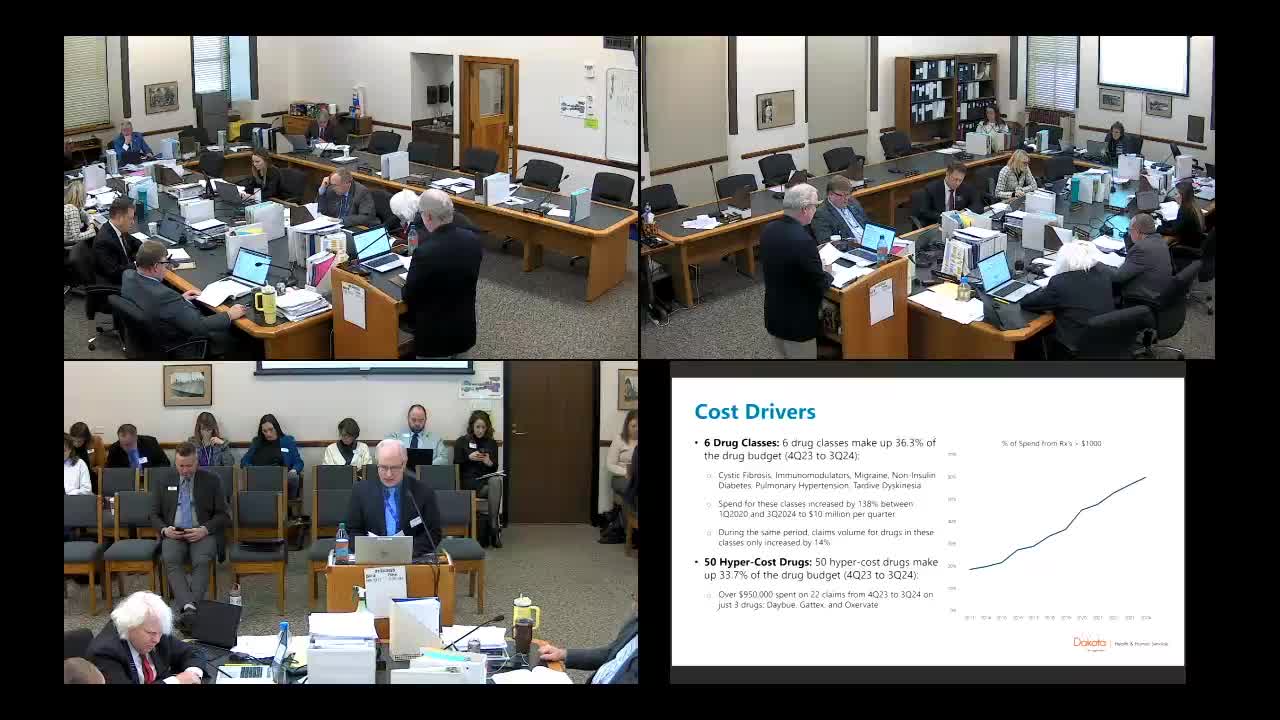State officials report drug costs surge to 60% of total healthcare spending
January 24, 2025 | Appropriations - Human Resources Division, House of Representatives, Legislative, North Dakota
This article was created by AI summarizing key points discussed. AI makes mistakes, so for full details and context, please refer to the video of the full meeting. Please report any errors so we can fix them. Report an error »

The House Appropriations - Human Resources Division meeting on January 24, 2025, focused on the rising costs of prescription drugs and the impact of biologics on the state’s healthcare budget. Key discussions highlighted the significant increase in spending on high-cost medications, particularly those exceeding $1,000 per dose, which now account for nearly 60% of total drug costs.
During the meeting, representatives examined the trend of specialty drugs, which are often the most expensive and contribute substantially to the overall budget. The data revealed that six drug classes—cystic fibrosis, immunomodulators, migraine treatments, non-insulin diabetes medications, pulmonary hypertension medications, and tardive dyskinesia medications—comprise 36% of the drug budget. Notably, spending in these categories surged by 138% from Q1 2020 to Q3 2024, reaching $10 million per quarter, despite only a 14% increase in claims volume.
The discussion also touched on the anticipated influx of new high-cost drugs, including 25 cell and gene therapy treatments, with 11 expected to exceed $2 million each. This raises concerns about the potential financial burden on the Medicaid system, particularly for families with multiple children requiring such treatments.
Rebates were emphasized as a crucial factor in managing drug costs. Since 1991, the state has collected $811 million in drug rebates, with a significant portion—$351 million—accumulated since the public health emergency began in 2020. The meeting underscored the importance of these rebates in offsetting the rising costs of medications.
Additionally, the challenges of implementing value-based agreements with drug manufacturers were discussed. These agreements, which could provide further savings, require extensive negotiation and tracking of patient outcomes, complicating their adoption.
In conclusion, the meeting highlighted the urgent need for strategies to address the escalating costs of prescription drugs, particularly high-cost biologics, and the importance of rebates and innovative agreements in mitigating these expenses for the state’s healthcare system. The division plans to continue exploring options to manage these challenges effectively.
During the meeting, representatives examined the trend of specialty drugs, which are often the most expensive and contribute substantially to the overall budget. The data revealed that six drug classes—cystic fibrosis, immunomodulators, migraine treatments, non-insulin diabetes medications, pulmonary hypertension medications, and tardive dyskinesia medications—comprise 36% of the drug budget. Notably, spending in these categories surged by 138% from Q1 2020 to Q3 2024, reaching $10 million per quarter, despite only a 14% increase in claims volume.
The discussion also touched on the anticipated influx of new high-cost drugs, including 25 cell and gene therapy treatments, with 11 expected to exceed $2 million each. This raises concerns about the potential financial burden on the Medicaid system, particularly for families with multiple children requiring such treatments.
Rebates were emphasized as a crucial factor in managing drug costs. Since 1991, the state has collected $811 million in drug rebates, with a significant portion—$351 million—accumulated since the public health emergency began in 2020. The meeting underscored the importance of these rebates in offsetting the rising costs of medications.
Additionally, the challenges of implementing value-based agreements with drug manufacturers were discussed. These agreements, which could provide further savings, require extensive negotiation and tracking of patient outcomes, complicating their adoption.
In conclusion, the meeting highlighted the urgent need for strategies to address the escalating costs of prescription drugs, particularly high-cost biologics, and the importance of rebates and innovative agreements in mitigating these expenses for the state’s healthcare system. The division plans to continue exploring options to manage these challenges effectively.
View full meeting
This article is based on a recent meeting—watch the full video and explore the complete transcript for deeper insights into the discussion.
View full meeting
